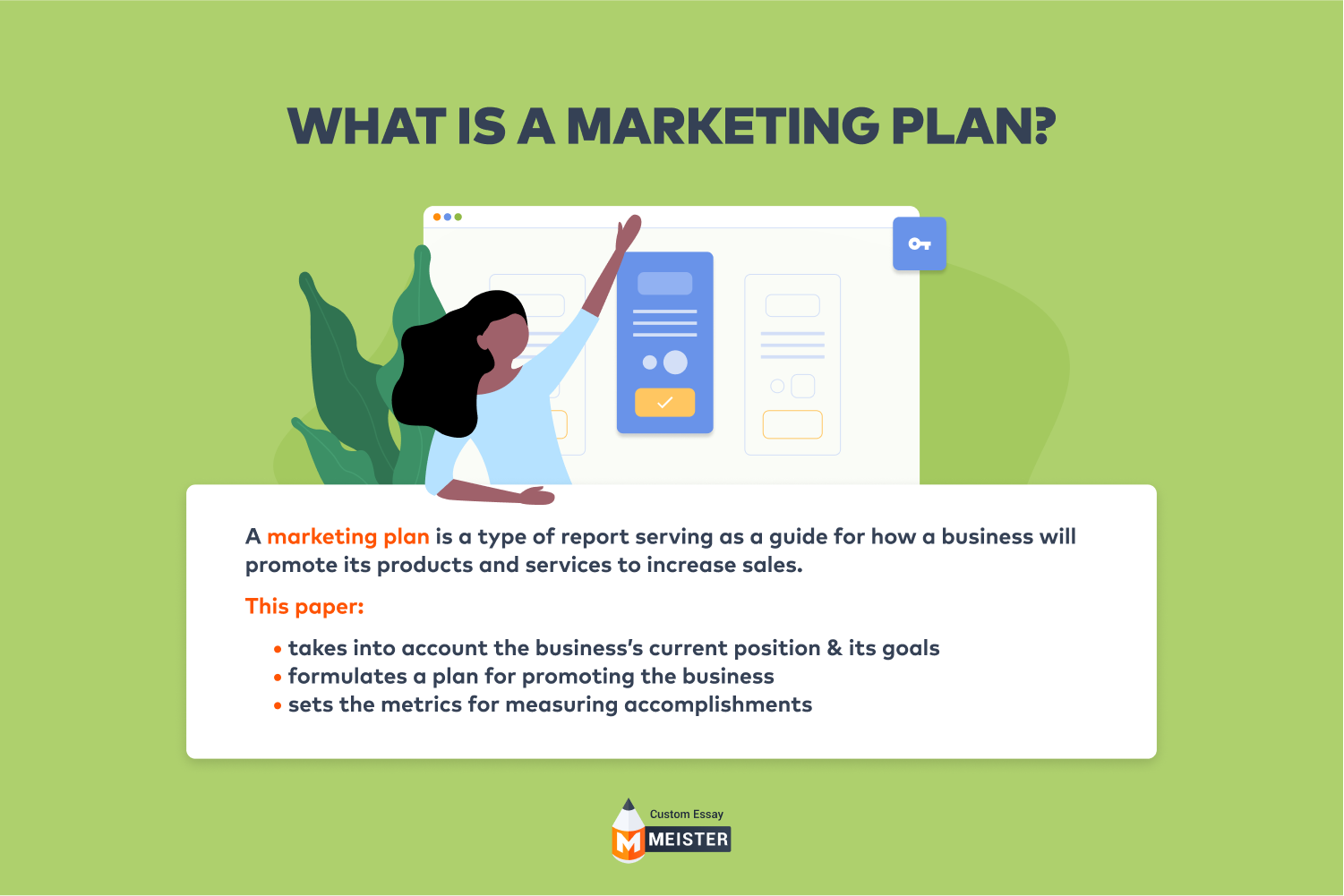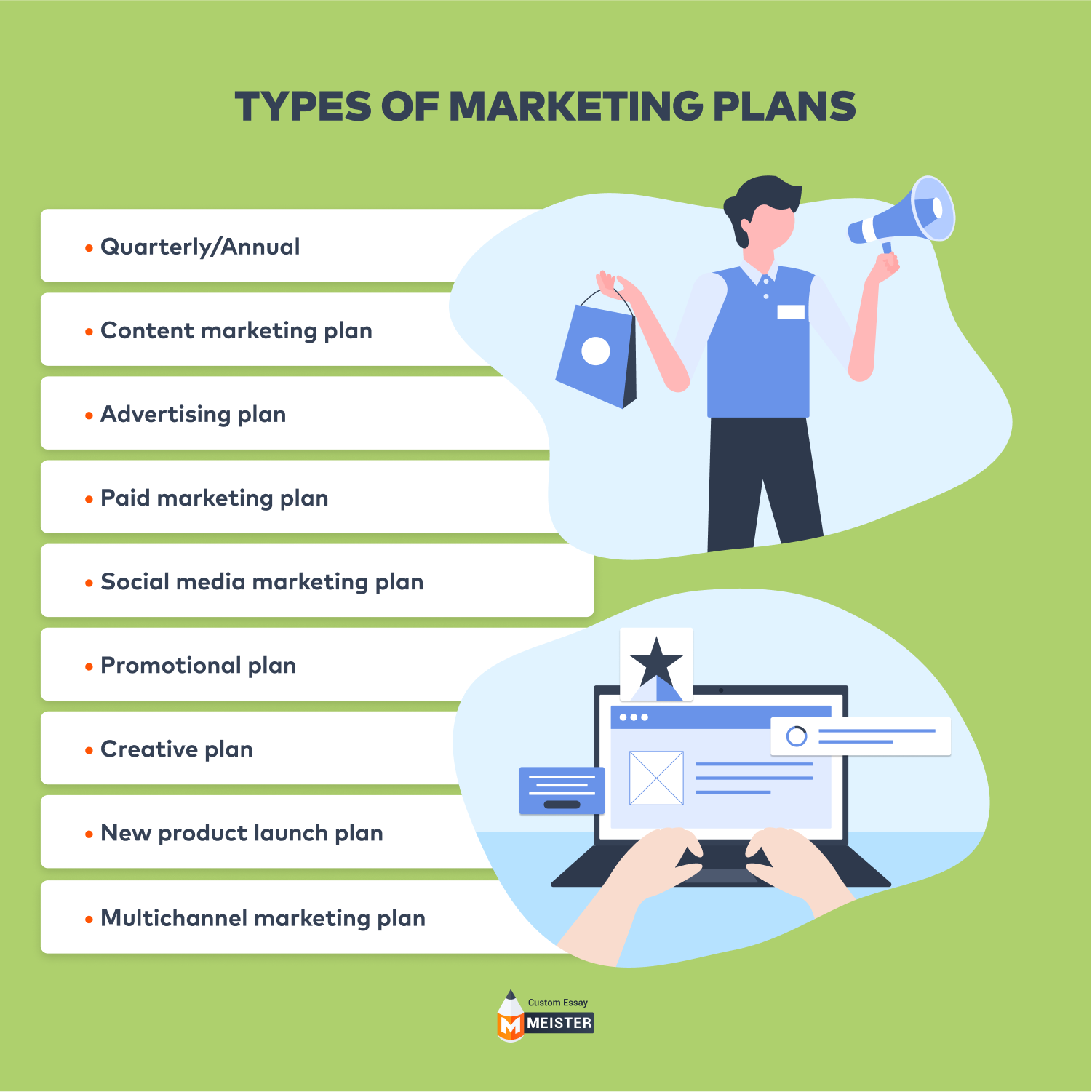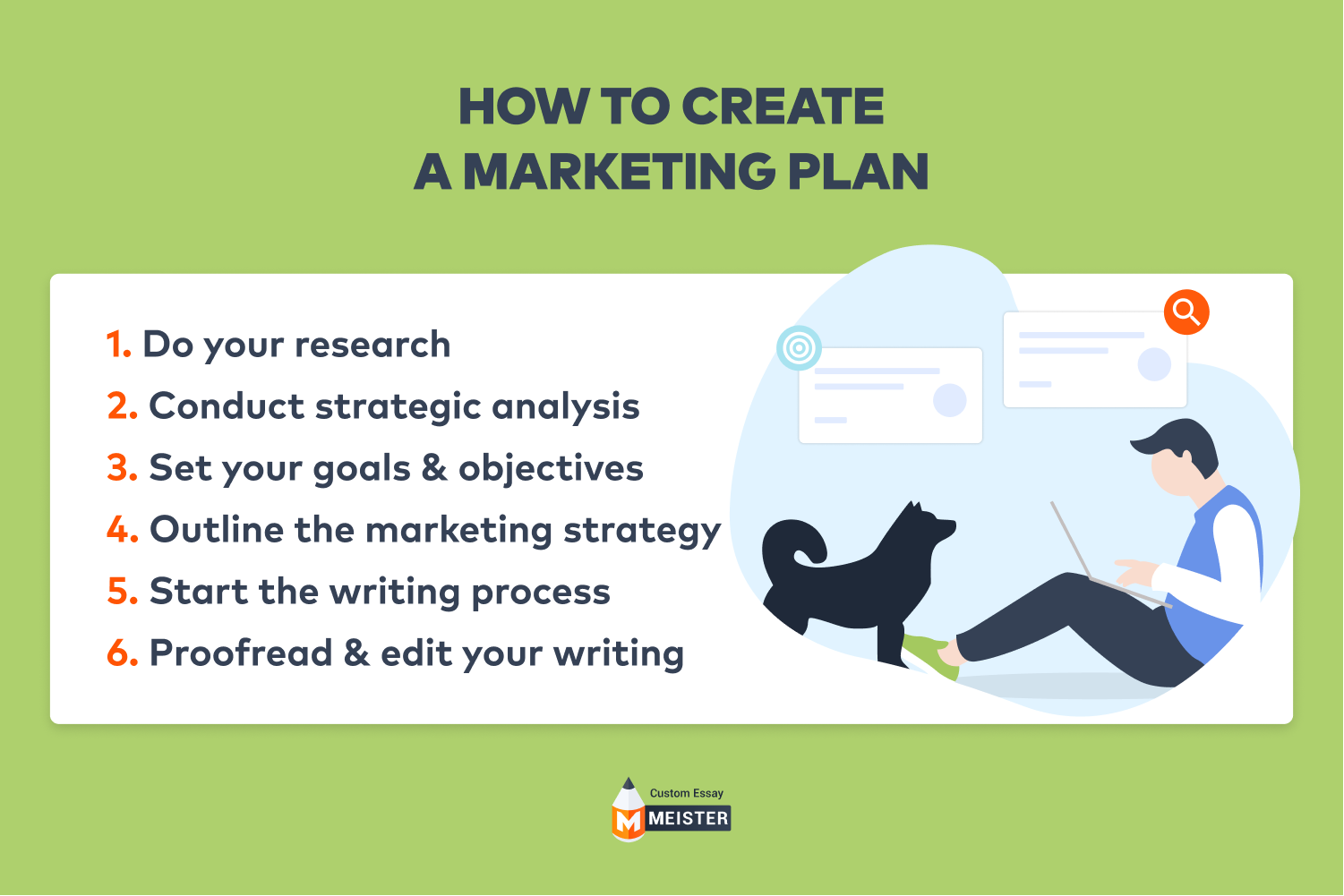How To Create A Marketing Plan—With Examples For Students And Professionals
So, you have been asked to write a marketing plan, and are not sure where to start. Do not worry. This is, indeed, a complex report to accomplish, but you do not need to do it all on your own. Read on to understand what it is, why it is important, and finally, how to write a marketing plan.
What Is a Marketing Plan?
A marketing plan is a type of report that serves as a guide for how a business will promote its products and services to increase sales. This document takes into account the business’s current position and its goals. Based on these, the author formulates a plan for promoting the business, as well as sets the metrics for measuring accomplishments.

A professional marketing plan could be highly detailed—including specifics for multiple campaigns—or something basic, depending on the company’s goals. These are crucial to all types of businesses because they ensure the company’s success. Promoting a business without this strategic document is like going into battle without a sword.
Why You Need a Marketing Plan
A marketing plan is important for any business that takes its business goals seriously. For students, it is a must to know how to write this type of report effectively. It is the foundation for a successful business. Knowing its various purposes for companies may help you appreciate why you need to write one. This document serves numerous purposes:
A blueprint. It details the goals and ways the company aims to achieve these goals. It makes sure that every person and team involved is headed in the same direction.
Maintaining focus. With a document that explicitly states the goal and strategies, companies avoid constantly changing strategies and requirements, which would result in unmet goals. This document makes it easier to filter out activities and strategies that do not align with their established goals.
Specific goals and strategies. This document takes into account internal and external factors. Thus, it ensures that all efforts remain aligned with the company’s business goals. Furthermore, the research required when writing this report helps make sure that your goals are attainable and that you establish realistic strategies.
Accountability. When everyone is well-informed about the goals and strategies of the company, as well as the metrics for measuring success, the team can move without constant supervision. At the same time, executives or business owners have a clear idea as to where their budget is spent.
As you can see, a marketing plan is an important document--a company’s success relies largely on its quality. So, it is not something that can be done by just anyone, and it should be done meticulously.

What Is the Difference Between Marketing Plan and Marketing Strategy?
Marketing plan and marketing strategy are often used interchangeably. Although they are closely related, they are not quite the same thing. If you are confused about these two terms, here are their main differences:
On the one hand, a marketing strategy deals with the fundamental aspects of marketing. It holds the bigger picture, such as how you intend on accomplishing your business goals. Thus, it encompasses different campaigns and projects. However, it does not delve into the specifics of what your department will do. Marketing strategy examples include content, inbound, conversational, and social media marketing, as well as Search Engine Optimization. This strategic document typically focuses on these factors:
- Products/services you offer
- Your target audience
- What your company stands for
- The brand’s message and guidelines
- Your niche or industry
- Main competitors
On the other hand, based on the marketing plan definition provided earlier, it is a document that supports the company’s strategy. This document dives into the specifics of how you will execute your plans and accomplish business goals. In this document, the focus is no longer on the fundamentals but on the actions and projects—the initiatives, tactics, campaigns, and promotions you will execute during a specific time frame, as well as the tools and platforms that will be used to facilitate success.
Marketing strategies, which are handled by higher-level executives, such as the Chief Marketing Officer, are the basis for the creation of marketing plans, which are handled by the Marketing Manager. One important aspect to remember is that the latter changes more often than the former. Read on to learn more about this core strategic document.
Types of Marketing Plans
There are different types of marketing plans, and each one focuses on a different strategy or time frame. This is because compressing details for all strategies in one document may result in a very long paper, especially for companies with complex strategies. Thus, you may find yourself creating more than one type of plan, depending on what your team handles. Here are the most common types of marketing plans for business:
- Quarterly or Annual – this highlights the campaigns to be executed within a quarter or year. This document encompasses the different strategies and campaigns to be implemented by the whole department.
- Content Marketing Plan – this plan deals with different strategies and campaigns that use content to promote the business. This type of plan specifies blog topics and target keywords for a website.
- Advertising Plan – this document specifies how you will utilize the different advertising platforms, such as print, TV, radio, e-mail, or digital media.
- Paid Marketing Plan – focuses initiatives and strategies encompassing paid search, paid social media, display, as well as influencer marketing.
- Social Media Marketing Plan – specifies strategies, projects, and content to be executed across various social media platforms.
- Promotional Plan – strategies and tactics for advertising a specific product are detailed in the promotional plan. This includes the key messages, promotion type, and promotional activities, usually for a new product.
- Creative Plan – this one focuses on the brand’s core message that will be communicated across all communication and advertising channels. This is based on the company’s goals and data from strategic analyses.
- New Product Launch Plan – defines the strategies and activities in preparation for and during the launch of a new product.
- Multichannel Marketing Plan – this document specifies the strategy for interacting with clients through a combination of different communication channels. It ensures that clients have a seamless and positive experience even as they interact with the company on different platforms.
Depending on your company’s strategy, you may be asked to create a few of these types of plans. As a professional, it will be to your advantage to be familiar with and know how to write a plan for these different aspects.

Elements of Creating a Marketing Plan
Marketing plans tend to vary depending on industry, company, and goals. However, some elements remain constant, regardless of the type of plan. These elements are the core of any plan you will write:
Executive Summary – presents an overview of the contents or main points of the document.
Environmental Analysis – presents information about the company’s current position in the industry, its target market, and its performance in relation to its objectives. This section contains sub-sections detailing both internal and external factors.
Marketing goals and business objectives – this section expounds on the company’s and the department’s goals, as well as a time frame for achieving them.
Strategic Analysis – this section gives a more in-depth analysis of the company’s current position in the industry. Various marketing strategy tools may be used to analyze the influences of internal and external factors on the company.
Marketing Strategies – this section outlines the strategies set to achieve the company’s goals. This is included in the document to ensure that the initiatives are guided accordingly.
Marketing Implementation – this section specifies how the company will implement its strategies, such as how the company will be organized, roles and responsibilities of the team, the activities, and timetables.
Performance Metrics – presents how success will be measured and evaluated. This will be used at the end of the plan’s time frame to evaluate if the plan succeeded and then identify areas for improvement.
Professors and companies may have their own report formats but you will find that each one contains these foundational elements in one form or another. In fact, you could use these elements as a basis for your marketing plan outline. The hallmark of a professional is knowing exactly what each marketing planning element requires—an accomplishment that takes years of training and experience and lots of writing and research.
Deadline Approaching?
We work 24/7 and we are affordable (from $13.95/page). Our writers, managers and support agents all have been involved in academic ghostwriting for years. We can assist even with the most difficult writing assignment under time constraints.




How to Create a Marketing Plan
Just like writing a research paper , writing a marketing plan is never completely linear. The process may seem confusing for beginners, but if you follow this guide, you will soon master how to build a marketing plan like a professional.
1. Do your research
A lot of research goes into this document. Ample research allows you to have a firm understanding of how the industry works, how the company is situated, what the customers need and want, and therefore make better decisions. Do the following research before writing your report:
Industry analysis — dynamics of your industry and the company’s situation relative to competitors)
Competitive analysis — identifying competitors, their strengths and weaknesses
Market research — target audience, buyer persona, buying cycle, etc.
This research will give you the foundation for setting SMART goals and choosing the right tools to further help you formulate a comprehensive report.
2. Conduct strategic analysis
A strategic analysis allows you to understand the company’s internal and external environment. It will help you understand your company’s context, assess current strategies, forecast future trends or opportunities and threats. To do this, you will need the data from your research and use a variety of tools:
SWOT Analysis (Strengths, Weaknesses, Opportunities, Threats)
PESTLE (Political, Economic, Social, Technological, Legal, Environmental)
Porter’s Five Forces Analysis (Supplier power, Buyer Power, Threat of new entrants, Threat of substitute products or services)
BCG Matrix (Market share vs. growth rate)
Market Segmentation Chart (Demographic, Geographic, Psychographic, Behavioral segments)
Analyzing your research with these tools will help you gain a better understanding of your company’s context. The strategic analysis takes time, but do not skip it because it offers a wealth of information that will fortify your strategies.
3. Set your goals & objectives
Without goals and objectives, you would be running around in a field without scoring. In other words, your report would be useless without goals and objectives. Your marketing goals are different but should be aligned with the business goals. When creating goals and objectives, remember to keep them SMART—specific, measurable, achievable, relevant, and time-bound.
Use the outcomes of your research and strategic analysis to formulate SMART goals and objectives. The following questions will help you create well-defined goals:
Specific:
- What do you want to accomplish?
- Why is this important?
- Who are the stakeholders?
- Is it location-based? Where?
- Which resources will be needed?
Measurable:
- Define the quantitative aspect of the goal (i.e., how much/many?)
- How do you know when you have achieved the goal?
Achievable:
- Is the goal realistic given your current situation and resources?
- What do you need to do to accomplish this?
Relevant:
- Are they aligned with the business goals?
- Is this the right time to aim for them?
Time-bound:
- When should the goal be achieved?
- What can you do three months from now? Six months from now?
Your goals and objectives are one of the pillars of all your efforts. Without SMART goals, your strategy may not become as effective. This is why goal-setting comes after research and analysis and takes time to accomplish.

4. Outline the marketing strategy
In one summary paragraph, you should outline who you are targeting, the product’s image, the unique selling proposition, the pricing and positioning strategy, the core of your sales story, and the elements and tools you will use to communicate the message. Then, create a more detailed plan that describes the critical path for your strategy, as well as the performance metrics for each objective or activity. You may also create a calendar of their initiatives and activities here to help your team abide by the time-bound aspect of your goals.
5. The writing process
When you have established all these aspects, it is time to start writing. Like writing an academic essay , start writing the main body until the conclusion first before the introduction and executive summary. Follow the elements of a marketing strategies plan as your outline. Start your writing process with the environmental analysis, the goals and objectives, situational analysis, strategies, projects and campaigns, marketing implementation, and performance metrics, then the conclusion.
A. Environmental Analysis – start by writing about the company, its target demographic and buyer personas, and its unique product offerings. Then, based on the situational analysis you performed, write a brief explanation of the company’s current position in the industry, competition, and its performance (i.e., if objectives are being met).
B. Goals and Objectives – this is where you summarize the company’s business objectives and the marketing goals that supplement them. Then, explain how the succeeding initiatives will help achieve these goals and objectives.
C. Situational Analysis – write an in-depth analysis of the company’s position in the industry. Dedicate a sub-section for each strategic analysis you conducted. Be clear and straightforward in your analysis.
D. Marketing Strategies – familiarize yourself with your company’s strategies. Explain them briefly in this section.
E. Marketing Implementation – this section should include a few sub-sections depending on the complexity of your document. There should be a sub-section for each strategy or campaign you will implement. Be specific when you write the plans here.
F. Performance Metrics – determine how you will track the progress and success of your efforts. Set the measurements and KPIs. Make sure each component is explained clearly so all stakeholders understand what is expected.
G. Conclusion – wrap up your main points from the main body—reiterate the goals and objectives, the strategies, briefly gloss over the campaigns, then discuss the expected outcomes. These tips for writing a conclusion may help you.
H. Introduction – this is where you give your readers a summary of what to expect from the document. Go through the purpose of your report—your goals cannot be stressed enough in this type of document. You should also clarify what type of plan you are writing. Check out these tips for writing an introduction and great hooks for starting essays.
I. Executive Summary – this is the first paragraph in the document. Here, you summarize the entirety of your document, which is why it is written last. Talk about your goals, the company’s achievements or performance, your brand, and finally the company’s goals and the campaigns. You need to cram a lot of information in the executive summary, but do your best to be straightforward and concise to keep it in 3 paragraphs.
6. Proofread & edit your writing
Your report should appear professional. There should be no grammatical and typographical errors and it should follow the prescribed format of your company or professor. This way you can ensure that your report will successfully convey its message. Get a higher grade when you follow this editing checklist.
Sample Marketing Plans From CustomEssayMeister
A large part of writing this document is about the research, but the writing part is no easy feat either. After all, you need to translate into formal writing all your plans and ideas. If you feel like you are still feeling around in the dark, reading a few samples may help you. CustomEssayMeister has prepared a few examples you can use to inspire you in writing one for your class or company. Check them out here:
Notice how the authors of these documents wrote each section and how each project and campaign is aligned with the company’s strategy and findings of the strategic analysis. Notice, too, the use of language and how it differs from a college paper. Hopefully, these different samples will help you master how to write this document.
Custom Marketing Plan for Students and Professionals
Admittedly, writing this strategic document is complex, even with a comprehensive guide like this one. It requires thorough research and in-depth analysis, not to mention, great writing skills. You need to invest a lot of time to master how to make a marketing plan, but once you have, you are sure to become a valuable asset to the company you work for. Set off your career path in the right direction with CustomEssayMeister’s custom marketing plan. Our professional writers can help you create a report for a hypothetical business or your actual business or company. Order now.


